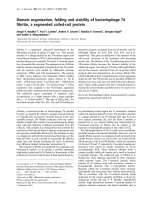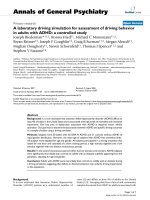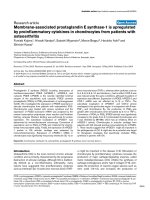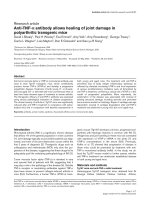Báo cáo y học: "Array comparative genomic hybridisation-based identification of two imbalances of chromosome 1p in a 9-year-old girl with a monosomy 1p36 related phenotype and a family history of learning difficulties: a case report" pps
Bạn đang xem bản rút gọn của tài liệu. Xem và tải ngay bản đầy đủ của tài liệu tại đây (364.37 KB, 6 trang )
BioMed Central
Page 1 of 6
(page number not for citation purposes)
Journal of Medical Case Reports
Open Access
Case report
Array comparative genomic hybridisation-based identification of
two imbalances of chromosome 1p in a 9-year-old girl with a
monosomy 1p36 related phenotype and a family history of learning
difficulties: a case report
Gregory J Fitzgibbon*
1
, Jill Clayton-Smith
2
, Siddharth Banka
2
,
Susan J Hamilton
1
, Margaret M Needham
1
, Jonathan K Dore
1
, Jake T Miller
1
,
Gareth D Pawson
1
and Lorraine Gaunt
1
Address:
1
Regional Cytogenetics Unit, Saint Mary's Hospital, Hathersage Road, Manchester, M13 0JH, UK and
2
Clinical Genetics Department,
Saint Mary's Hospital, Hathersage Road, Manchester, M13 0JH, UK
Email: Gregory J Fitzgibbon* - ; Jill Clayton-Smith - ;
Siddharth Banka - ; Susan J Hamilton - ;
Margaret M Needham - ; Jonathan K Dore - ;
Jake T Miller - ; Gareth D Pawson - ; Lorraine Gaunt -
* Corresponding author
Abstract
Introduction: Monosomy 1p36 is one of the most common terminal deletion syndromes, with an approximate
incidence of 1 in every 5000 live births. This syndrome is associated with several pronounced clinical features
including characteristic facial features, cardiac abnormalities, seizures and mental retardation, all of which are
believed to be due to haploinsufficiency of genes within the 1p36 region. The deletion size varies from
approximately 1.5 Mb to 10 Mb with the most common breakpoints located at 1p36.13 to 1p36.33. Over 70% of
1p36 deletion patients have a true terminal deletion. A further 7% have interstitial deletions and a proportion
have a derivative chromosome 1 where the 1p telomere is replaced by material from another chromosome,
either as a result of a de-novo rearrangement or as a consequence of malsegregation of a balanced parental
translocation at meiosis.
Case presentation: Array comparative genomic hybridisation analysis of a 9-year-old Caucasian girl presenting
with dysmorphic facial features and learning difficulties, for whom previous routine karyotyping had been normal,
identified two submicroscopic rearrangements within chromosome 1p. Detection of both an insertional
duplication of a region of 1p32.3 into the subtelomeric region of the short arm of a chromosome 1 homologue
and a deletion within 1p36.32 of the same chromosome instigated a search for candidate genes within these
regions which could be responsible for the clinical phenotype of the patient. Several genes were identified by
computer-based annotation, some of which have implications in neurological and physical development.
Conclusion: Array comparative genomic hybridisation is providing a robust method for pinpointing regions of
candidate genes associated with clinical phenotypes that extend beyond the resolution of the light microscope.
This case report provides an example of how this method of analysis and the subsequent reporting of findings
have proven useful in collaborative efforts to elucidate multiple gene functions from a clinical perspective.
Published: 19 November 2008
Journal of Medical Case Reports 2008, 2:355 doi:10.1186/1752-1947-2-355
Received: 9 May 2008
Accepted: 19 November 2008
This article is available from: />© 2008 Fitzgibbon et al; licensee BioMed Central Ltd.
This is an Open Access article distributed under the terms of the Creative Commons Attribution License ( />),
which permits unrestricted use, distribution, and reproduction in any medium, provided the original work is properly cited.
Journal of Medical Case Reports 2008, 2:355 />Page 2 of 6
(page number not for citation purposes)
Introduction
Unbalanced chromosome rearrangements account for a
significant proportion of phenotypic abnormalities
within the population. Varying levels of dysmorphism
and mental retardation are attributable to deletions or
amplifications of functional regions within the genome.
Subtelomeric deletions are a frequent cause of phenotypic
abnormalities [1]. The gene rich content of the subtelom-
eres in comparison to the rest of the human genome [2]
makes them an analytical priority for conventional and
molecular cytogenetic investigations [3].
Monosomy 1p36 is one of the most common and well
characterised subtelomeric deletion syndromes and is
associated with mental retardation and multiple congeni-
tal abnormalities [4]. The estimated prevalence of this dis-
order is 1 in 5000 live births [5]. The clinical features of
monosomy 1p36 include deep-set eyes, straight eyebrows
positioned low on the supra-orbital ridges, asymmetric
ears, pointed chin and a flat nasal bridge. Additional fea-
tures include developmental delay, cardiomyopathy,
hearing impairment and seizures (reviewed in [6]), [7].
The 1p36 region is thought to contain numerous tumour-
suppressor genes, which is evident by the association of a
variety of neoplasms in patients with deletions of this
chromosome location [8,9].
Interstitial duplications of the short arm of chromosome
1 are rare with a varied phenotype. A large duplication of
chromosome 1 (1p31–1p35) has been previously
reported in a baby with low birth weight and post natal
growth retardation, congenital heart disease, mid face
hypoplasia, ambiguous genitalia and hypoplasia of the
phalanges. This child survived for only a short time after
birth [10]. A case involving a direct duplication of chro-
mosome 1, dir dup(1)(p21.2–p32) was described in a boy
with multiple congenital anomalies. These included
microcephaly, malformed ears, anteverted nostrils, con-
vergent squint, micrognathia, hypoplasia of the terminal
phalanges, clinodactyly of the fifth fingers, simian creases,
left inguinal hernia, cryptorchidism, and severe postnatal
growth retardation [11]. A third case involving a duplica-
tion of 1p22.3–1p32.3 was described for a child present-
ing with sex-reversal, mid face abnormalities, an eczema-
like skin condition and severe growth retardation [12].
Finally, a 1p31–1p34.1 duplication was reported in a
child with craniosynostosis, developmental delay and gut
malrotation [13].
Array comparative genomic hybridisation (aCGH) is a
high-throughput method used to detect small copy
number changes within the genome that are not always
visible by conventional microscopy. This is achieved by
competitive binding of patient DNA against a 'normal'
control DNA to a target sequence which is anchored to a
glass slide. The high-dimensional data produced from all
of the genomic target sequences is interpreted using an
integrated suite of bioinformatic tools.
In comparison to conventional cytogenetic techniques,
aCGH enables a more precise examination of the genome,
allowing the detection of previously unidentified submi-
croscopic imbalances and also redefinition of breakpoints
in previously identified chromosome imbalances. The
ability to accurately map breakpoints means that aCGH
has become an efficient strategy in identifying candidate
chromosomal loci and genes. This case report highlights
the use of aCGH not only to detect submicroscopic dele-
tions and duplications, but also to localise disease gene
regions for subsequent candidate gene identification.
Case presentation
A 9-year-old Caucasian girl presented to the genetic clinic
with mild to moderate learning disability. She was noted
to have numerous dysmorphic features including a small
mouth with heaped up palate, a small chin and a small
over folded ear, straight eyebrows, fifth finger clinodactyly
and short toes. She had required grommets for treatment
of glue ear and had hypermetropia. An 11-week scan
detected nuchal oedema and ventriculomegaly was
detected on a later antenatal scan. She was of normal birth
weight but had feeding difficulties including reflux from
birth. A delayed ability to sit, speech delay, and late walk-
ing at 22 months were also noted. Height and weight were
both in the 50–75
th
centile at four and a half years old
with an occipital-frontal circumference in the 98
th
centile.
A diagnosis of Di George syndrome was initially suspected
and she was referred for 22q11 fluorescence in situ
hybridisation (FISH) analysis and routine cytogenetic
investigations, both of which revealed an apparently nor-
mal female karyotype (46, XX). Examination of the sub-
ject's mother revealed some mild dysmorphism,
clinodactyly of the fifth finger and mild learning disabil-
ity. The maternal grandmother was also assessed and was
phenotypically normal. The proband's father was not
available for assessment, however it was reported that he
had fathered another child of different maternal origin
who also displayed growth and developmental problems.
The proband was the eldest of three sisters, all of whom
had different fathers. The second sister had intra uterine
growth retardation and low birth weight (4lb 3oz at 37
weeks), with all growth parameters <0.4
th
centile at 23
months. Similar dysmorphic features as evident in the
proband were noted, including small mouth and chin.
Cutis marmorata, long slim feet, complete 2/3 syndactyly
of the toes and mild to moderate learning disability were
also present. Conventional cytogenetic analysis of this sib-
ling revealed a normal female karyotype.
Journal of Medical Case Reports 2008, 2:355 />Page 3 of 6
(page number not for citation purposes)
The youngest sister showed an apparently normal devel-
opment, with mild dysmorphia similar to that of her
mother. Currently, the proband's mother is pregnant with
a fourth child of different paternity, and has undergone
prenatal diagnosis, the conventional cytogenetic analysis
for which has revealed a normal female karyotype.
aCGH was performed on DNA from the proband using
the Version 2 CytoChip™ from BlueGnome. These arrays
are constructed using clones from the widely validated
Roswell Park (RP) Cancer Institute Bacterial Artificial
Chromosome (BAC) library. The quality control (QC)
parameters for diagnostic reporting of this experiment
were met with a spot inclusion of 99.71% and a standard
deviation (SD) of the autosome value of 0.061 (failure
thresholds are <95% and >0.075, respectively) from a 5
μm scan. The scan results, processed by BlueFuse software
(BlueGnome), revealed two major genomic imbalances.
The first was a five BAC clone deletion between 1.4 and 2
Mb long, mapping to 1p36.32. These clones were (in
order of most distal): RP3-395M20, RP11-333E3, RP4-
785P20, RP11-46F15 and RP1-286D6.
The second imbalance was an amplification of two contig-
uous clones, at 1p32.3 between 0.4 and 1.7 Mb in length.
These clones were (in order of most distal): RP11-117D22
and RP11-243A18. The aCGH results for these imbalances
of chromosome 1 are illustrated by a scatter plot (Figure
1). The 1p36 deletion was confirmed by FISH using fluo-
rescent probes from two of the five clones (RP11-333E3
and RP11-46F15). Confirmation of the 1p32.3 amplifica-
tion by FISH (using fluorescent probes from both RP11-
117D22 and RP11-243A18) revealed the duplicated seg-
ment to be inserted at a position distal to its normal locus,
situated within the subtelomeric region of chromosome
1p (Figure 2). Parental samples were requested in order to
ascertain the origin of this rearrangement. A paternal sam-
ple was unavailable but FISH analysis of the mother,
grandmother and siblings of the proband revealed a nor-
mal diploid compliment in each case for all of the inves-
tigated clones. At present, it cannot be determined
whether the chromosomal anomalies found in the
proband were the result of a de-novo rearrangement of 1p
or familial inheritance from her father.
In silico analysis of the deleted and duplicated BAC clones
through interrogation of the Ensembl database http://
www.ensembl.org/Homo_sapiens/index.html revealed
numerous characterised and unknown genes using both
the Ensembl and EST transcript gene tracks. Additional
file 1 summarises the genes associated with the five
deleted BAC clones on 1p36.32 and the two duplicated
clones on 1p32.3, in relation to their putative function.
Also listed are those genes that lie within the flanking
sequences between the deleted clones and neighbouring
clones, which may also have been included in the copy
number changes.
Discussion
Monosomy 1p36 is known to cause a range of clinical fea-
tures including moderate to severe learning difficulties. In
this paper, we describe a 9-year-old girl who displayed
some of the clinical features associated with deletions of
1p36 and also less well characterised features that may
represent a phenotypic manifestation of the 1p32 duplica-
tion were identified. Despite similar features identified in
other family members, it is thought likely that the dele-
tion and amplification of the specific genes found at the
loci described in this patient have contributed to her pro-
nounced clinical phenotype. Gajecka et al. [14] catego-
rised the clinical features found in subjects with terminal
or interstitial 1p36 deletions. Comparisons of this list,
drawn in relation to the proband, confirm the presence of
the less well documented phenotypes, including ear
asymmetry (40% of patients), clinodactyly (60%), feed-
ing difficulties (77%), reflux (56%), hearing problems
(77%) and more commonly speech and developmental
delay (100%, 98%) [14]. The presence of the 1p32 ampli-
fication in this patient, however, prevents a clear geno-
type/phenotype association for this subject.
Some of the clinical features listed in the proband are
likely to be a result of haploinsufficiency of one or more
of the genes identified by in silico interrogation of the
deleted BAC clones. An example would be to speculate an
association between the learning difficulties, develop-
mental delay and speech delay identified in the proband
with the deletion of PLCH2. The PLCH2 gene is expressed
in mammalian brain tissue including the cerebral cortex
[15], a region known to be responsible for memory,
thinking and understanding language. Despite the theo-
retical nature of this approach, this search method can ini-
tiate further investigations into such candidate genes.
There are already candidate genes associated with mono-
somy 1p36 that have been previously correlated with spe-
cific phenotypic features (reviewed in [14]). The SKI
proto-oncogene is a likely candidate for cleft lip/palate
found in 17% of monosomy 1p36 patients. An epilepsy
candidate gene KCNAB2 was found to be deleted in the
majority of seizure prone 1p36 patients, and human
gamma-aminobutyric acid A receptor delta-subunit gene
(GABRD) has been implicated in abnormal neurodevel-
opment. These candidate genes are located at a position
distal to the deleted region described in our patient, and
may explain the absence of these particular features in our
proband.
There is little published material specifically relating to
1p32 duplications. All previous reports encompass much
Journal of Medical Case Reports 2008, 2:355 />Page 4 of 6
(page number not for citation purposes)
larger duplicated regions of 1p from which a more severe
phenotype would be expected in comparison to this case.
Therefore, the relevance of this finding with respect to the
genes identified within this region is not yet clear.
Conclusion
It is apparent that with the advent of aCGH as a diagnostic
tool for detecting unbalanced genomic rearrangements, it
will become easier to correlate specific phenotypic fea-
tures with the underlying genotype and to identify candi-
date genes which may be responsible for specific clinical
features. This case report provides an example of how
identification of small deletions using aCGH may help to
dissect out the different phenotypic features of relatively
common microdeletion syndromes and facilitate correla-
tion of these with specific genes within the chromosomal
regions concerned.
Consent
Written informed consent was obtained from the patient's
family for publication of this case report and any accom-
panying images. A copy of the written consent is available
for review by the Editor-in-Chief of this journal.
Competing interests
The authors declare that they have no competing interests.
Authors' contributions
GJF conducted the array CGH work, performed the data
analysis relevant to this case report and drafted this man-
uscript. JCS and SB provided all clinical details and genetic
counselling for the patients. SJH performed the checking
procedures for this case and revised the manuscript. MMN
and GJF conducted the in silico data analysis. JKD and
GDP carried out the FISH analysis for all patients. JTM
performed the required DNA extractions and reviewed the
manuscript. LG undertook the aCGH analysis and revised
the manuscript.
Array comparative genomic hybridisation scatter plotFigure 1
Array comparative genomic hybridisation scatter plot. An array comparative genomic hybridisation scatter plot for
chromosome 1 generated by BlueFuse microarray analysis software (BlueGnome) showing the five Bacterial Artificial Chromo-
some clone deletions (BACs RP3-395M20, RP11-333E3, RP4-785P20, RP11-46F15 and RP1-286D) within 1p36.32 (arrowed)
and the two Bacterial Artificial Chromosome clone duplications (BACs RP11-117D22 and RP11-243A18) within 1p32.3 (aster-
isked). The log2 ratios of the patient vs. reference DNA is shown on the vertical axis (mean log2 ratio of -0.6 for the deletion
and 0.38 for the amplification) and the position of each Bacterial Artificial Chromosome along chromosome 1 is shown along
the horizontal line. The location of the observed abnormalities is viewed in relation to a chromosome 1 ideogram, with the
deletion represented in red and the duplication represented in green.
*
Journal of Medical Case Reports 2008, 2:355 />Page 5 of 6
(page number not for citation purposes)
Additional material
Acknowledgements
We are grateful to the family discussed in this report for their approval in
the publication of this work.
References
1. Flint J, Knight S: The use of telomere probes to investigate sub-
microscopic rearrangements associated with mental retar-
dation. Curr Opin Genet Dev 2003, 13:310-316.
2. Saccone S, De Sario A, Della Valle G, Bernardi G: The highest gene
concentrations in the human genome are in telomeric bands
of metaphase chromosomes. Proc Natl Acad Sci USA 1992,
89:4913-4917.
3. Knight SJ, Horsley SW, Regan R, Lawrie NM, Maher EJ, Cardy DL,
Flint J, Kearney L: Development and clinical application of an
innovative fluorescence in situ hybridization technique
which detects submicroscopic rearrangements involving tel-
omeres. Eur J Hum Genet 1997, 5:1-8.
4. Shapira SK, McCaskill C, Northrup H, Spikes AS, Elder FF, Sutton VR,
Korenberg JR, Greenberg F, Shaffer LG: Chromosome 1p36 dele-
tions: the clinical phenotype and molecular characterization
of a common newly delineated syndrome. Am J Hum Genet
1997, 61:642-650.
5. Shaffer LG, Lupski JR: Molecular mechanisms for constitutional
chromosomal rearrangements in humans. Annu Rev Genet
2000, 34:297-329.
Additional file 1
Deleted and duplicated genes in the proband.
Click here for file
[ />1947-2-355-S1.doc]
Metaphase fluorescence in situ hybridisation imagesFigure 2
Metaphase fluorescence in situ hybridisation images. Metaphase fluorescence in situ hybridisation analysis using the
probes for the Bacterial Artificial Chromosome clones RP11-333E3 (A) and RP11-46F15 (B). Both probes (arrowed) show only
a single green signal, confirming a deletion within 1p36 (observed in a total of 10 cells). Fluorescence in situ hybridisation anal-
ysis using the probes for the Bacterial Artificial Chromosome clones RP11-117D22 (C) and RP11-243A18 (D) both show three
green signals (duplicated regions are arrowed), confirming a duplication of the clones within 1p32.3 (observed in a total of 10
cells) and identifying the distal location of the duplicated region within the p-arm of chromosome 1.
AB
C
D
Publish with BioMed Central and every
scientist can read your work free of charge
"BioMed Central will be the most significant development for
disseminating the results of biomedical research in our lifetime."
Sir Paul Nurse, Cancer Research UK
Your research papers will be:
available free of charge to the entire biomedical community
peer reviewed and published immediately upon acceptance
cited in PubMed and archived on PubMed Central
yours — you keep the copyright
Submit your manuscript here:
/>BioMedcentral
Journal of Medical Case Reports 2008, 2:355 />Page 6 of 6
(page number not for citation purposes)
6. Slavotinek A, Shaffer LG, Shapira SK: Monosomy 1p36. J Med Genet
1999, 36:657-663.
7. Shaffer LG, Heilstedt HA: Terminal deletion of 1p36. Lancet 2001,
358(Suppl):S9.
8. White PS, Maris JM, Beltinger C, Sulman E, Marshall HN, Fujimori M,
Kaufman BA, Biegel JA, Allen C, Hilliard C, Valentine MB, Look AT,
Enomoto H, Sakiyama S, Brodeur GM: A region of consistent
deletion in neuroblastoma maps within human chromosome
1p36.2–36.3. Proc Natl Acad Sci USA 1995, 92:5520-5524.
9. Thompson FH, Taetle R, Trent JM, Liu Y, Massey-Brown K, Scott KM,
Weinstein RS, Emerson JC, Alberts DS, Nelson MA: Band 1p36
abnormalities and t(1;17) in ovarian carcinoma. Cancer Genet
Cytogenet 1997, 96:106-110.
10. Elejalde BR, Opitz JM, de Elejalde MM, Gilbert EF, Abellera M, Meisner
L, Lebel RR, Hartigan JM: Tandem dup (1p) within the short arm
of chromosome 1 in a child with ambiguous genitalia and
multiple congenital anomalies. Am J Med Genet 1984,
17:723-730.
11. Mohammed FM, Farag TI, Gunawardana SS, al-Digashim DD, al-Awadi
SA, al-Othman SA, Sundareshan TS: Direct duplication of chro-
mosome 1, dir dup(1)(p21.2–p32) in a Bedouin boy with mul-
tiple congenital anomalies. Am J Med Genet 1989, 32:353-355.
12. Wieacker P, Missbach D, Jakubiczka S, Borgmann S, Albers N: Sex
reversal in a child with the karyotype 46, XY, dup (1)
(p22.3p32.3). Clin Genet 1996, 49:271-273.
13. Garcia-Heras J, Corley N, Garcia MF, Kukolich MK, Smith KG, Day
DW: De novo partial duplications 1p: report of two new cases
and review. Am J Med Genet 1999, 82:261-264.
14. Gajecka M, Mackay KL, Shaffer LG: Monosomy 1p36 deletion syn-
drome. Am J Med Genet C Semin Med Genet 2007, 145C(4):346-356.
15. Nakahara M, Shimozawa M, Nakamura Y, Irino Y, Morita M, Kudo Y,
Fukami K: A novel phospholipase C, PLC(eta)2, is a neuron-
specific isozyme. J Biol Chem 2005,
280:29128-29134.









